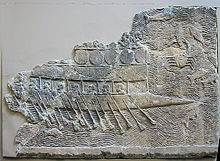- Marsala (ship)
-
General characteristics Type: Liburnian "long ship" Length: about 115 feet (35 meters) Propulsion: oared vessel
17 sweeps per sideThe Marsala Ship is the earliest warship known from archeological evidence.[1] It is a wreck discovered in 1969 in an area called Punta Scario in the harbor of Marsala in western Sicily, Italy, near the Aegadian Islands.[2] The Marsala Ship's "nationality" was painted on the sides with letters by its Punic builders from Carthage. [3]
Contents
Ship
Its architecture and contents show that it was not a merchant cargo ship. A merchant cargo ship made regular journeys and required large containers for storing water. It also needed grinders and mortars for dried food. It would normally carry large pots for communal cooking. It would also have fish-hooks for catching available fresh fish.[2]
The Marsala Ship had only small cups and bowls for individual servings. Its wine, water, and other liquids were carried in amphorae of miscellaneous shapes. Food remains were fresh and perishable, such as various kinds of butchered meat. Bones of deer, horses, oxen, sheep, goats and pigs were all found. All this indicated it was intended as a warship and not as a merchant cargo vessel. The presence of ballast stones and lack of merchant cargo definitely indicate that it was a warship, probably used for scouting purposes or for ramming smaller boats. The remains of marijuana stems — which may have been chewed by the oarsmen — were also found in the wreck.[2]
It is believed to have been one of the Liburnian "long ships", an oared vessel with 17 sweeps per side used by ancient Carthage in the Battle of the Aegates Islands (241 BC).[2] This was the last battle of the First Punic War between Carthage and the Roman Republic. Carbon-14 tests on timbers and other materials determined a date of 235 BC.[3]
The vessel was determined to be approximately 115 feet (35 meters) long and 15.7 feet (4.8 meters) wide.[3]
Excavation
It was in 1969 that a captain of a commercial dredge digging sand for making glass discovered buried wood from ancient vessels in the area of Punta Scario.[2] In 1971 the movement of a sandbank exposed the "Punic Ship's" stern post with projecting timber.[2] This endangered the shipwreck, threatening the loss of the potential historical value of the information it revealed about the Phoenicians. Rescue excavation began in earnest and continued for the next four years.[3]
The Sicilian authorities and the British School at Rome appointed Honor Frost to direct the excavation. Frost and her international team of marine archeologists excavated the site. Progress reports were published yearly in the International Journal of Nautical Archaeology (London and New York). When the field-work ended, a comprehensive report was published by the 'Accademia Nazionale dei Lincei (Rome) as a Supplement to Notizie degli Scavi di Antichità, XXX (1976).[2]
Some extremely rare finds amongst the shipwreck were a plaited basket, a piece of rope fashioned into a simple eye splice, a little brush, a knife blade, a spade, and a couple of toggles. Also found were parts of a human skeleton, possibly of a Carthaginian sailor trapped by the ship's ballast.[3]
Notes
- ^ Anzovin, p. 275 item 4240 The first warship known from archeological evidence is the Marsala Ship, a wreck discovered in 1969 in the harbor of Marsala in western Sicily, Italy.
- ^ a b c d e f g "The Marsala Punic Warship by Honor Frost". http://www2.rgzm.de/navis/home/..%5CShips%5CShip056%5CNaveMarsalaEnglish.htm. Retrieved 2008-09-07.
- ^ a b c d e "Saudi Aramco World magazine article -The Punic Warship". http://www.saudiaramcoworld.com/issue/198606/the.punic.warship.htm. Retrieved 2008-09-07.
Bibliography
- Anzovin, Steven et al., Famous First Facts International Edition, H. W. Wilson Company (2000), ISBN 0-8242-0958-3
- Council for Nautical Archaeology (Great Britain) 1983, International Journal of Nautical Archaeology and Underwater Exploration, Original at University of Michigan, Frost, Honor et al., 1981, Lilybaeum (Marsala) The Punic Ship: Final excavation report.
- Delgado edition, Encyclopedia of Maritime and Underwater Archaeology, Yale University Press (1998), ISBN 0-3000742-7-1
- Frost, Honor, How Carthage Lost the Sea: Off the Coast of Sicily, a Punic Warship Gives up its Secret, Natural History, December 1987; 58–67
- Paine, Lincoln P., Warships of the World to 1900, Houghton Mifflin Books (2000), ISBN 0-3959841-4-9
- Research Reports — National Geographic Society 1973, page 261, pp. 151–166; also chapter 12 in 1981 report.
Categories:- Ancient shipwrecks
- Marsala
- Ships preserved in museums
- Treasure from shipwrecks
- Shipwrecks in Italy
- Shipwrecks in the Mediterranean
Wikimedia Foundation. 2010.

